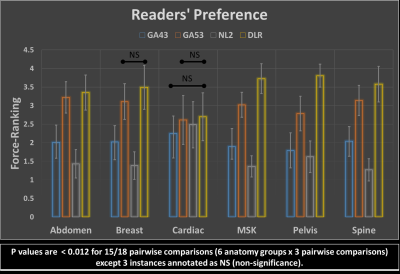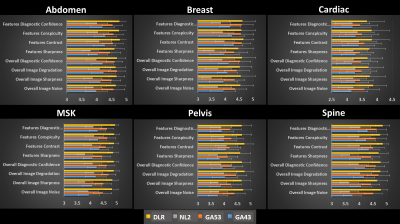Hung Do1, Mo Kadbi1, Dawn Berkeley1, Brian Tymkiw1, and Erin Kelly1
1Canon Medical Systems USA, Inc., Tustin, CA, United States
1Canon Medical Systems USA, Inc., Tustin, CA, United States
In this randomized blinded multi-reader study, Deep Learning Reconstruction (DLR) was
shown to be well generalized to data prospectively acquired from 16 anatomies. Specifically, DLR was scored similar or statistically higher than the 3
conventional reconstruction methods compared.

Figure 5: Force-ranking summary. DLR’s average force-ranking score is
consistently higher than the other methods in all pairwise comparisons and in
all anatomy groups. DLR was rated statistically higher than the 3 counterparts
in 15/18 pairwise comparisons (p < 0.012) except the three instances annotated
by as NS (non-significance).

Figure 4: Average readers’ scores for 6 anatomy groups. DLR’s average
scores are consistently higher than those of the 3 other methods in 143/144 pairwise
comparisons (6 anatomy group x 8 criteria x 3 pairwise comparisons) except 1
instance, where DLR’s average score is smaller than that of GA53 by a margin less
than 1% (i.e. 4.63 for DLR vs. 4.67 for GA53). DLR is rated statistically
higher all other three methods (p < 0.017) in 134/144 pairwise
comparisons.
